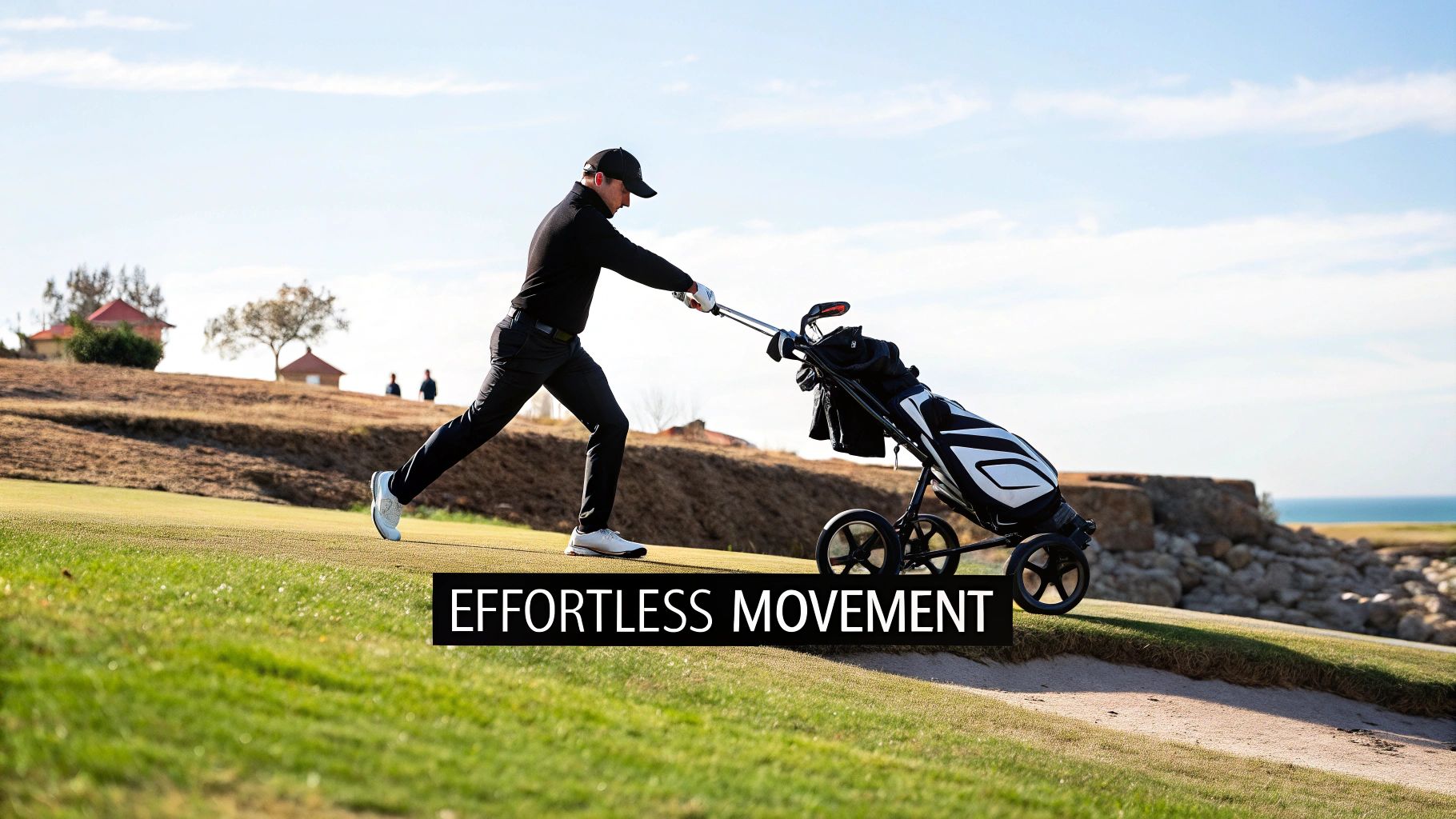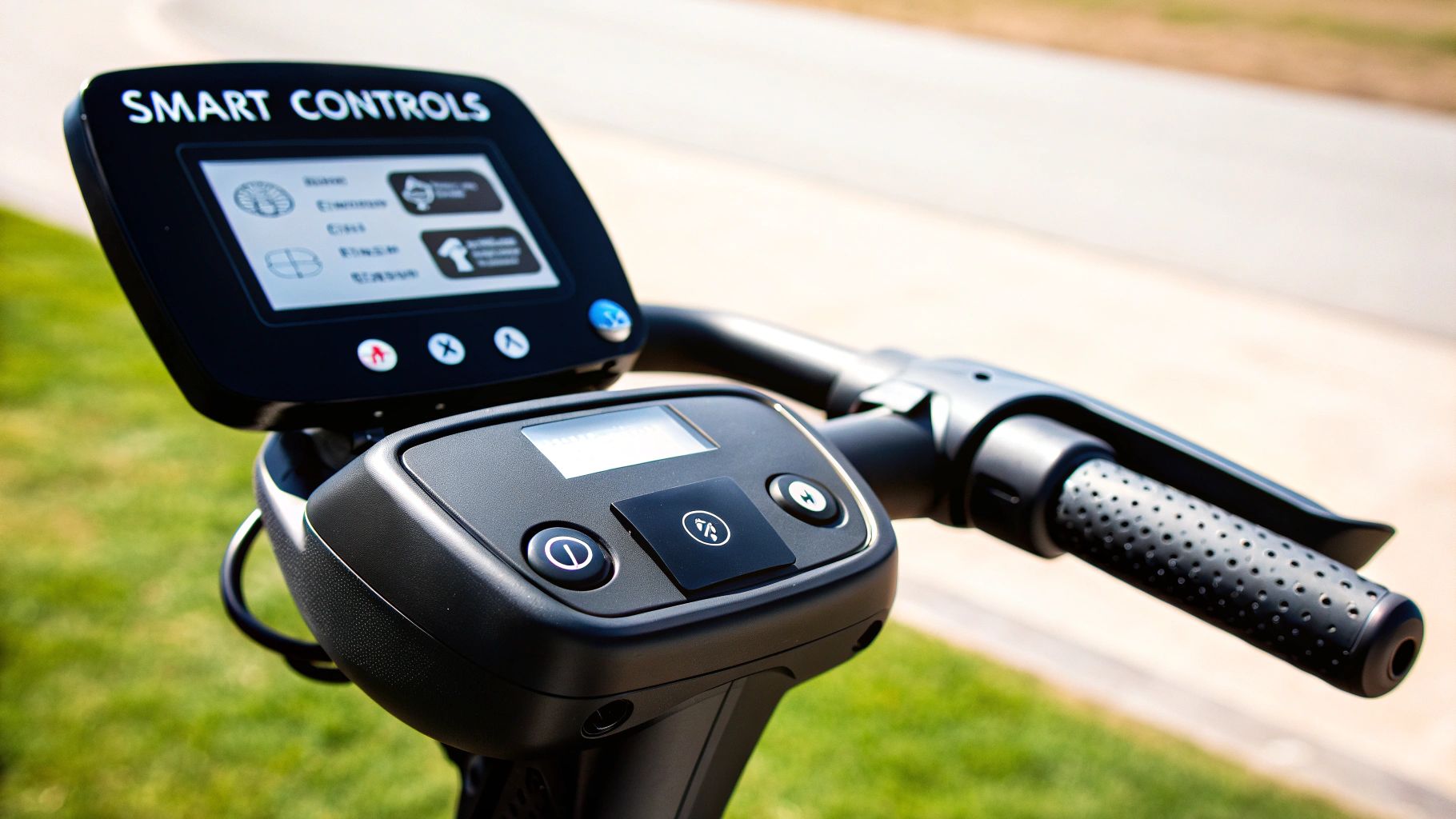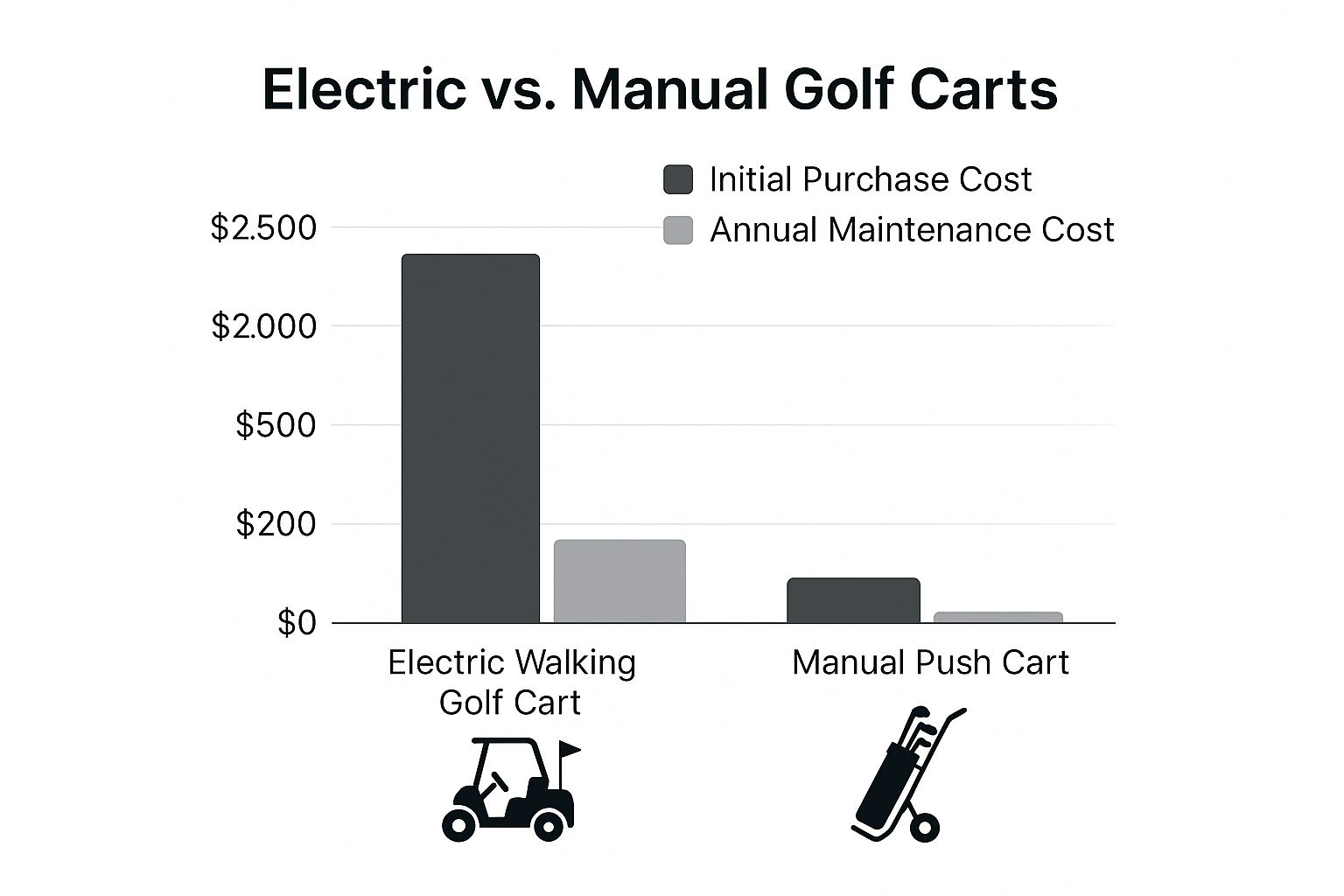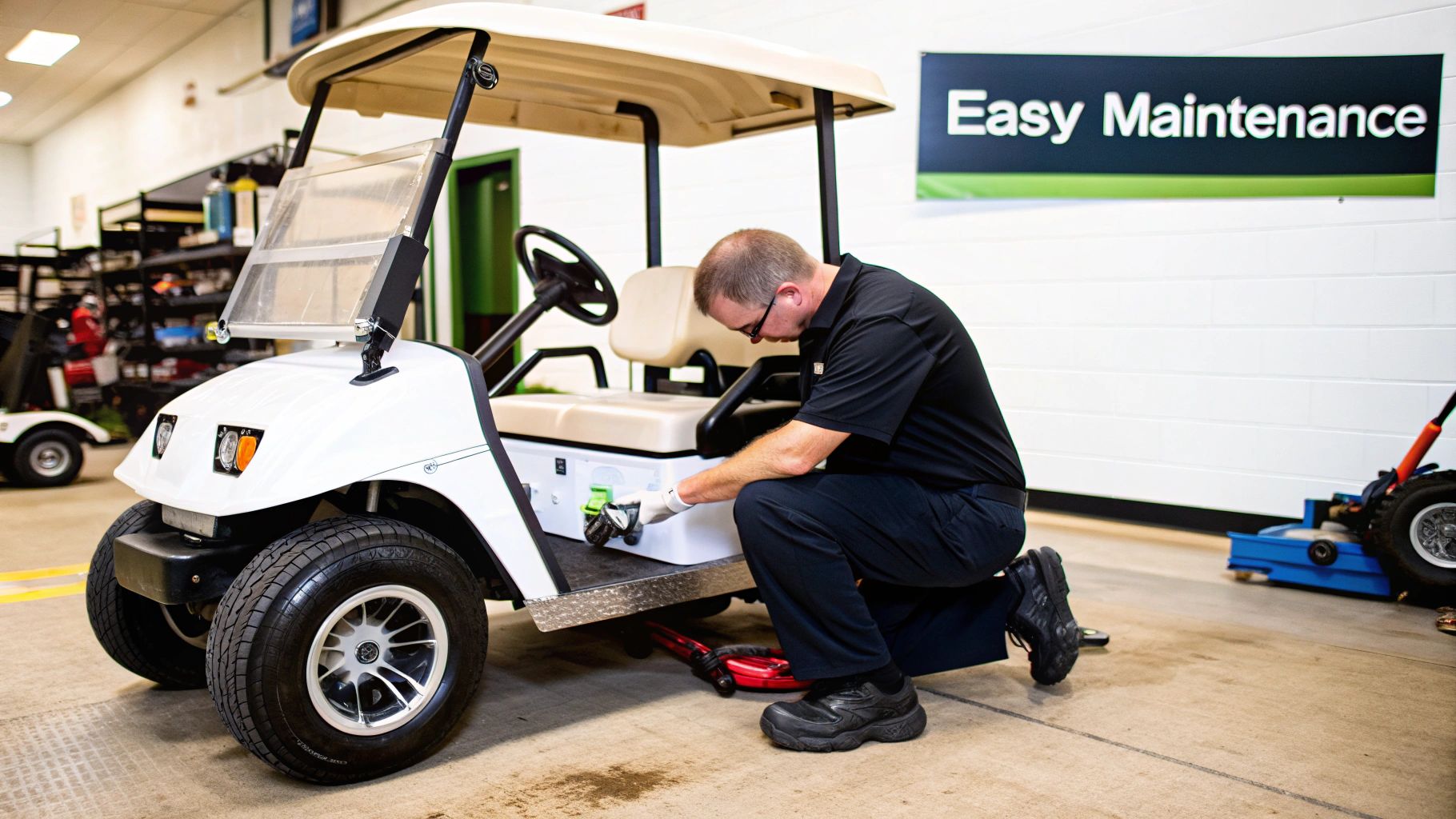For golfers who love to walk the course, electric walking carts are the perfect middle ground. They blend the pure health benefits of walking with the sheer convenience of having a caddy. These smart devices, also known as electric golf trolleys, carry your bag for you, letting you conserve energy and focus completely on your game.
Why Walkers Are Choosing Electric Golf Caddies

The classic image of a golfer is someone either lugging a heavy bag or zipping around in a cart. But more and more players are discovering a third option that delivers the best of both worlds. This shift toward electric walking golf carts isn't just a trend; it's a move toward a more immersive and physically rewarding game without the burnout.
Walking the course connects you to the rhythm of the game in a way riding just can't match. You feel the slopes of the fairway under your feet, you notice how the wind is really blowing, and you get more time to think through your next shot. The problem? Hauling a 30-pound bag for four hours can turn that pleasant walk into a grueling workout, wrecking your posture and tiring out your swing by the back nine.
Enhancing the Golfing Experience
This is where electric caddies change everything. They take the physical load off your shoulders—literally. Instead of dreading the next uphill climb, your energy is saved for what really matters: hitting great shots.
It’s not just about feeling less tired; it’s about playing better golf. Many players find their focus is sharper and their stamina lasts through all 18 holes, leading to lower scores and a much more enjoyable round. As you'll see, the many benefits of electric push carts for golfers show a direct line between this technology and a better performance on the course.
By taking away the physical strain of carrying or pushing a bag, you can stay in peak mental and physical shape from the first tee to the final putt. That sustained energy is a huge factor in playing consistently well.
The Rise of a Booming Market
This isn't just talk, either—the numbers back it up. As golfers look for smarter and more eco-friendly ways to play, the demand for these advanced caddies has shot up.
The market for electric remote control golf carts was valued at USD 1.2 billion and is expected to hit USD 2.5 billion by 2033, growing at a compound annual growth rate (CAGR) of 9.2%. That kind of growth shows a real change in what players want.
Decoding the Tech Behind Top Electric Caddies

To pick the right electric walking golf cart, you have to look past the flashy marketing and get a feel for the technology that actually powers your round. Seemingly small features on a spec sheet can make a huge difference over 18 holes. This guide breaks down what really matters so you can make a choice you’ll be happy with on the course.
A cart’s motor is its engine, but don’t get fixated on raw power alone. A beefy motor, often in the 24v 380Wh range, is crucial for conquering steep hills without bogging down, especially if you’re hauling a heavy staff bag. But that power needs to be paired with quiet operation—a loud, whiny motor is a serious distraction when you're lining up a putt.
The best motors deliver a smooth, gradual start, not the jerky launch you find on cheaper models. They also need enough torque to keep a steady pace whether you're in the thick rough or on a paved path.
Battery Life and On-Course Endurance
Battery performance is, without a doubt, the most critical factor. Manufacturers usually talk about battery life in terms of holes—typically 18, 27, or 36 holes on one charge. My advice? Always choose a model that offers more than your typical round. Hilly courses and heavy bags drain batteries faster than you'd think.
There's a reason lithium-ion batteries are the gold standard. They’re lighter, charge up faster, and have a much longer lifespan than the old lead-acid types. A cart that promises 36 holes isn’t just for marathon golf days; it’s about having peace of mind that you won’t be pushing a dead cart up the 18th fairway.
A cart’s ability to complete 36 holes is not just about convenience; it’s a buffer against unexpected conditions. Think of it as a reliability feature that ensures your technology never fails you, even on a long or challenging day of golf.
Remote Control Versus Follow Technology
Understanding how you'll steer the cart is key, as it completely shapes your on-course experience. You’ll find two main systems, and each appeals to a different kind of golfer.
- Remote Control: This is the classic setup. You use a small handheld remote to manually steer the cart—forward, back, left, and right. It gives you total control to navigate tight spots around bunkers, greens, and your playing partners.
- Follow Mode: This is the high-tech, hands-free option. By clipping a small sensor to your belt or back pocket, the cart uses Bluetooth to automatically follow you as you walk, keeping a set distance behind you.
While follow mode is the ultimate in convenience, a good remote is still essential for precision handling in tricky areas. The best carts offer both, giving you the flexibility to switch between modes. You might use follow mode on the open fairway, then switch to the remote when navigating through a crowded area near the clubhouse.
Stability and Portability
Finally, don’t overlook the cart’s physical design. A low center of gravity and a wide wheelbase are non-negotiable for stability, preventing tips on sidehills or uneven lies. Many premium electric walking golf carts even add a smaller, anti-tip wheel at the back for extra security on steep uphill climbs.
Portability is all about what happens when the round is over. Pay attention to the cart's folded size and total weight. A lightweight frame and a simple, one-click folding mechanism make a world of difference when you’re lifting it into your trunk. Some models even fold down smaller than a standard push cart, which is a huge win for anyone tight on storage space.
Head-to-Head: The Best Electric Walking Golf Carts
Alright, let's get to the fun part—pitting the top contenders against each other. When you're looking at premium electric walking carts, the choice often boils down to subtle differences in technology, on-course performance, and overall design philosophy. We’re going to break down three of the best models out there: the Stewart Golf Q Follow, the Foresight Sports ForeCaddy, and the MGI Zip Navigator.
This isn't just about reading a spec sheet. It's about understanding how those features actually help you on the course. We'll look at everything from their control systems to how they handle tough terrain, helping you pinpoint the perfect cart for your game.
The Gold Standard: The Stewart Golf Q Follow
The Stewart Golf Q Follow is often considered the one to beat in this category, and for good reason. It's built around what is arguably the most polished "follow" technology available today.
Using a small Bluetooth handset that clips right onto your belt or back pocket, the Q Follow literally tracks your every move. It maintains a perfect distance behind you as you walk, creating a true hands-free experience that feels like you have a personal caddie. The responsiveness is uncanny—it stops when you stop and goes when you go, with no jerky movements or lag.
But the Q Follow is more than just a one-trick pony. It also features a full remote-control mode, giving you pinpoint command when you need to navigate tight spots around the green or a crowded tee box. This dual capability is a massive plus, offering the best of both worlds.
The real magic of the Stewart Q Follow is how seamlessly it switches between autonomous following and manual remote control. You get the luxury of a hands-free stroll down the fairway and the precise steering you need around hazards.
The build quality is top-notch, with a compact, foldable design that makes it one of the easiest premium carts to get in and out of your car. Its blend of sophisticated tech and thoughtful engineering makes it a fantastic choice for golfers who prioritize convenience and are ready to invest in a superior on-course experience.
The Powerhouse: The Foresight Sports ForeCaddy
While Stewart focuses on a seamless follow experience, the Foresight Sports ForeCaddy is engineered for pure power and stability. This thing is an absolute beast on any terrain.
The ForeCaddy comes equipped with a high-performance battery and a beast of a motor, designed to conquer even the most ridiculously hilly courses without breaking a sweat. If your home club has serious elevation changes, this cart's hill-climbing power and sturdy build will give you unmatched confidence.
Its control system is driven by a remote with four distinct modes:
- Manual: A standard power-assisted push mode.
- Remote: Full directional control from the handset.
- Power Brake: Actively slows the cart on steep downhills.
- March: Sends the cart ahead for a preset distance.
The lack of a true "follow" mode is the key difference when comparing it to the Stewart Q Follow. For some, that might be a dealbreaker. But for golfers who prefer the direct control of a remote, the ForeCaddy's powerful and highly responsive system is a major win. You can dive deeper into these comparisons in our guide to the top electric walking carts of 2025.
The Agile Contender: The MGI Zip Navigator
The MGI Zip Navigator carves out its own space by focusing on incredible maneuverability and a user-friendly design. It's a fully remote-controlled cart that truly excels at nimble navigation.
Its standout feature is the patented Gyroscope Straight Tracker technology. This system keeps the cart rolling in a straight line, even on sidehill lies and bumpy fairways, which means you spend less time fiddling with the remote to make constant corrections. It's a practical feature that just works.
The Zip Navigator also has a swiveling front wheel, giving it an exceptionally tight turning radius. This makes it incredibly easy to pilot around sharp corners, weave through trees, or navigate around bunkers. If you play on courses with complex layouts, that agility is a huge advantage. It even includes a rear anti-tip wheel for extra stability on hills.

The market for these carts is booming for a reason. The electric golf cart market was valued at USD 1.7 billion and is expected to grow at a CAGR of 8.7% through 2034. This growth is driven by golfers recognizing the value of their operational simplicity and energy efficiency.
Electric Walking Golf Cart Specification Comparison
To make the differences crystal clear, here’s a direct comparison of the key specs. This table helps you quickly see how each model stacks up in performance, portability, and core features.
| Feature | Stewart Q Follow | Foresight Sports ForeCaddy | MGI Zip Navigator |
|---|---|---|---|
| Primary Control | Follow & Remote | Remote Control | Remote Control |
| Battery Life | Up to 36 Holes | Up to 36 Holes | Up to 36 Holes |
| Key Technology | Bluetooth Follow, Downhill Braking | 4-Mode Remote, Power Brake | Gyroscope Straight Tracker |
| Folded Size | Ultra-Compact | Moderate | Compact |
| Maneuverability | Excellent | Good | Exceptional (Swivel Wheel) |
| Ideal User | Tech-savvy golfer wanting luxury | Player on hilly, demanding courses | Golfer needing agile navigation |
As you can see, the "best" cart really depends on what you value most. Are you looking for the hands-free convenience of follow technology? The raw power needed for tough terrain? Or the surgical precision of an agile remote cart? Each of these models offers a compelling reason to buy, but for very different types of players and courses.
Finding the Right Cart for Your Game and Course

Choosing the best electric walking golf cart isn’t about grabbing the one with the longest feature list. It's about matching the right cart to your game and your home course. A machine that’s perfect for a flat, wide-open Florida layout might be a total nightmare on a hilly, tree-lined track up north.
The key is to figure out what kind of golfer you are. Once you see which profile fits you best, the right choice becomes much clearer, and you can zero in on the features that actually matter for your money.
The Tech Aficionado Golfer
Are you the guy in your foursome who always has the latest rangefinder or swing sensor? If you get a kick out of gadgets and automation, you’re a Tech Aficionado. For you, the ultimate on-course luxury is a truly hands-free experience.
Your search should start and end with carts that have advanced "follow" technology. The ability to clip a sensor to your belt and have the cart trail you down the fairway like a loyal caddie is the dream. Carts like the Stewart Golf Q Follow were built for this exact purpose, blending slick Bluetooth tracking with a premium, high-end feel.
For the Tech Aficionado, the goal is effortless integration. The cart should feel like a natural extension of your game, not another gadget you have to fiddle with. The less you touch the remote, the better.
The Course Purist Golfer
The Course Purist puts reliability and raw performance above all else. You play often, in any weather, and you need gear that just works. Flashy tech is nice, but you're more concerned with power, stability, and pure endurance.
For this type of golfer, a few things are non-negotiable:
- Battery Endurance: You need a battery that can handle 36 holes without a sweat, even on tough days. This isn't just for marathon rounds—it's about eliminating battery anxiety completely.
- Stability: A wide wheelbase and a low center of gravity are crucial for preventing tips on sidehills and bumpy fairways. Models known for being rock-solid, like the Foresight Sports ForeCaddy, should be on your radar.
- A Powerful Motor: You need an engine that attacks steep hills without whining or slowing to a crawl. Consistent power from the first tee to the 18th green is what you're after.
The Course Purist wants a workhorse. It's a cart that shows up, does its job flawlessly every time, and lets you focus on one thing: your score.
The Traveling Golfer
If you’re constantly packing up your clubs for weekend golf trips or bouncing between different courses, you're a Traveling Golfer. Your number one priority? Portability. A cart that’s a pain to transport is a cart that gets left in the garage.
When you're looking at different models, pay close attention to the folded dimensions and overall weight. A cart with a simple, one-step fold that collapses into a tiny package is your best friend. Look for models that are famously "trunk-friendly" and light, but without being too flimsy. The MGI Zip Navigator is a fantastic example of a cart that finds that sweet spot between agility and a compact, easy-to-haul design.
Matching the Cart to the Course Topography
Your home course’s layout is just as important as how you play. The terrain is what turns a "nice-to-have" feature into a "can't-live-without-it" necessity.
For Hilly Courses If your club has serious elevation changes, two features are non-negotiable: a powerful motor and an excellent braking system. A beefy motor ensures your cart doesn't get bogged down on the climb, while a downhill braking system keeps it from getting away from you on steep drops. An anti-tip wheel on the back is another must-have to stop it from flipping over backward on inclines.
For Flat Courses On flatter, more sprawling courses, climbing power takes a backseat. Here, battery life and maneuverability are king. You’ll want a cart that can easily go 36 holes, letting you play back-to-back rounds without reaching for the charger. A swiveling front wheel is also a huge advantage, making it a breeze to navigate tight turns around bunkers and water hazards.
The True Cost of Owning an Electric Caddie
An electric caddie is a serious investment in your golf game, so understanding the total cost of ownership is the only way to make a smart purchase. It’s easy to focus on the initial price tag, which can run anywhere from several hundred to a few thousand dollars, but that's just the beginning of the story. To get a real sense of what you're spending—and the value you're getting back—you have to look at the long-term picture.
The biggest ongoing cost to plan for is the battery. Most modern electric walking golf carts are powered by high-performance lithium-ion batteries built to last for hundreds of rounds over many years. But like all batteries, they eventually wear out. You should budget for a replacement every three to five years, which will likely set you back between $250 and $500, depending on your caddie's model.
Warranty and Serviceability
A solid warranty is your best defense against surprise repair bills. The top brands usually offer a two-year warranty on the cart and its components, and some even provide extended coverage specifically for the battery. Before you commit, do a little digging into the brand’s reputation for customer service and check on the availability of spare parts. A cart that’s easy to service with parts that are easy to find will save you a ton of money and headaches down the road.
Beyond the hard numbers, you have to consider the intangible returns. Walking the course without the physical grind is a huge win for your health. More than that, the enhanced focus and pure enjoyment you get from the game can translate into better scores and a more fulfilling day every time you tee it up. For a detailed guide on what to expect with your first purchase, check out our electric golf push cart 101 guide.
The real value of an electric caddie isn't just about saving money on cart fees. It's in playing more often, feeling better after the round, and connecting with the game on a deeper level.
The Big Picture on Market Value
The explosive popularity of these caddies says a lot about their overall value. The global golf cart market, which includes these electric walking models, is a clear indicator of this trend, with projections showing it will hit $1504.5 million by 2025. This growth is driven by golfers who see that the upfront cost is easily offset by lower running costs, eco-friendly operation, and a far better on-course experience. If you're interested in market dynamics, you can dive into in-depth market research on golf carts.
When you weigh the initial price, future battery replacement, and potential service costs against what you'll save on cart rentals and the priceless health benefits, the financial picture gets a lot clearer. For any dedicated walking golfer, an electric caddie isn't just another piece of gear; it's a long-term investment in both your health and your hobby.
Our Final Take: The Right Cart for Your Game
After putting these carts through their paces, one thing is crystal clear: there’s no single “best” electric walking golf cart for every golfer. The right choice is deeply personal. It comes down to your home course, how you play, and what you really want from an on-course partner.
So, instead of crowning one overall winner, let’s get practical. This final breakdown cuts through the feature lists to give you clear, confident recommendations. We’ll pinpoint the perfect cart for tackling hills, the top pick for ultimate portability, and the model that delivers the best all-around value.
Best for Hilly Courses: Foresight Sports ForeCaddy
If your home course is a rollercoaster of steep climbs and nerve-wracking descents, the Foresight Sports ForeCaddy is, without a doubt, your champion. This machine was built with power and control at its core. Its beefy motor doesn't just climb hills; it attacks them without a hint of struggle.
But what truly seals the deal is the Power Brake feature. This active braking system is a game-changer on downhills, keeping the cart from running away from you. It's this one-two punch of raw climbing power and reliable braking that makes it the go-to for golfers who need a machine that can tame even the most demanding terrain.
Best for Portability: Stewart Golf Q Follow
For the golfer who travels or is just short on storage space, portability is everything. This is where the Stewart Golf Q Follow truly shines. It folds down into an amazingly small package that slips easily into just about any car trunk, proving you don’t need a massive machine for high-end performance.
But its compact size is matched by its incredible technology. The seamless Bluetooth "follow" mode is so good it feels like you have a pro caddie right there with you. It’s the perfect marriage of convenience, futuristic tech, and a design that’s incredibly easy to live with.
The Stewart Q Follow proves you don't have to sacrifice performance for portability. It delivers the most sophisticated follow technology on the market in a frame that is incredibly easy to transport and store.
Best Overall Value: MGI Zip Navigator
The MGI Zip Navigator hits that sweet spot right between advanced features, solid on-course performance, and a price that feels right. It skips the follow mode but makes up for it with a super-responsive remote control system loaded with practical, smart technology.
Its standout feature is the Gyroscope Straight Tracker. This keeps the cart rolling on a perfect line, even across tricky sidehill lies, which means you’re not constantly fiddling with the remote. Add in a swiveling front wheel for incredible agility, and you have a cart that’s both nimble and easy to manage. It delivers premium performance and thoughtful design, making it our top pick for golfers who want the most bang for their buck.
Common Questions About Electric Caddies
Thinking about getting an electric caddy? It's a great move, but you probably have a few questions floating around. Let's tackle the most common ones I hear from golfers to clear up any uncertainties before you make the investment.
How Long Will the Battery Actually Last?
This is the big one, and the honest answer is: it depends. Most quality carts today run on lithium-ion batteries that are rated for 18, 27, or 36 holes on a single charge. But you should always treat that 18-hole rating as the absolute minimum.
Things like a super hilly course, a heavy tour bag, or even slogging through wet, soft turf will drain the battery faster. To avoid the nightmare of pushing a dead cart up the 18th fairway, I always recommend going with a model rated for at least 27 holes. It just gives you peace of mind. A full recharge usually takes somewhere between four and eight hours.
What’s the Real Difference Between Remote and Follow Modes?
While both let you walk hands-free, they feel completely different on the course. I like to think of it as being a pilot versus having a chauffeur.
- Remote Mode: You're in total control. Using a small handheld remote, you steer the cart exactly where you want it to go. This is perfect for navigating tricky spots like tight paths, going around bunkers, or steering it to the next tee box while you head to the green.
- Follow Mode: This is the ultimate luxury. The cart uses Bluetooth to lock onto your remote and simply follows you from a set distance. You can just walk down the fairway, completely unburdened, and focus on your next shot.
The best electric caddies come with both modes. This gives you the freedom to use "follow" in open spaces and switch to precise remote steering when you need to thread the needle.
Can These Carts Actually Handle Super Hilly Courses?
Absolutely, but you have to pick the right one. If you play on a course with serious elevation changes, two features are completely non-negotiable: a powerful motor and a great braking system. A beefy motor, something in the 24v 380Wh range, will keep your cart from getting bogged down on steep climbs.
But going up is only half the battle. On hilly terrain, a downhill braking system is just as crucial. It stops the cart from getting away from you on descents, giving you total control and safety. Look for models with this feature or a dedicated anti-tip wheel for maximum stability.
What Kind of Maintenance Do Electric Caddies Need?
The good news is that modern electric caddies are built to be pretty low-maintenance. Your main jobs are just taking care of the battery and giving it a quick clean.
To get the most life out of your battery, always use the charger that came with it and try not to leave it sitting in a scorching hot car or a freezing garage. After a round, it’s a good habit to wipe down the frame and wheels to get rid of any dirt and grass. Other than that, just check every so often that the wheels are on tight and the tires look good, and your cart will run smoothly for years.
At Caddie Wheel, we believe in making the walking game accessible and effortless. Our innovative power assist system transforms your existing push cart into a powerful electric caddie. Explore the Caddie Wheel and enjoy a better walk.


Share:
7 Essential Types of Golf Equipment for Seniors in 2025
Your Guide to Golf Cart Battery Life